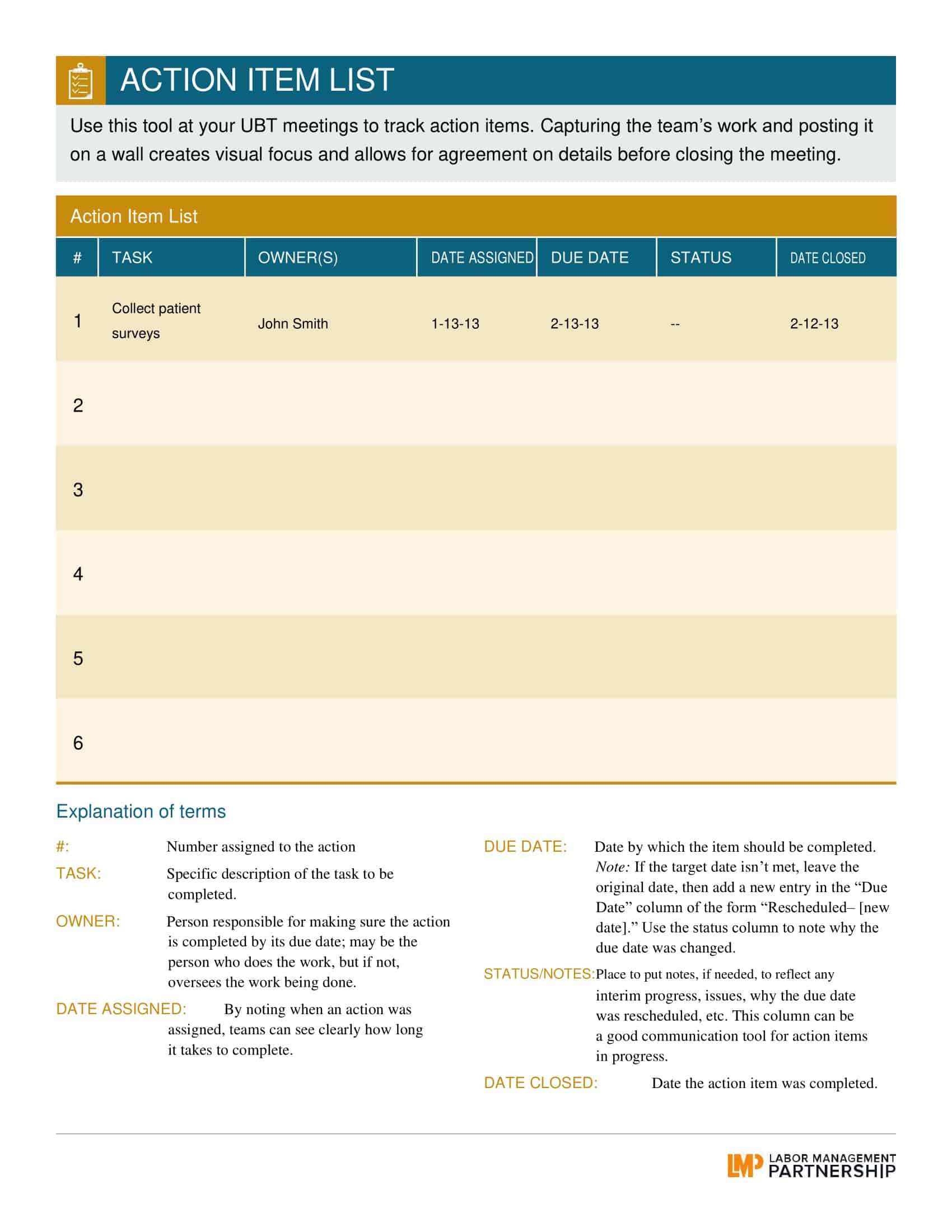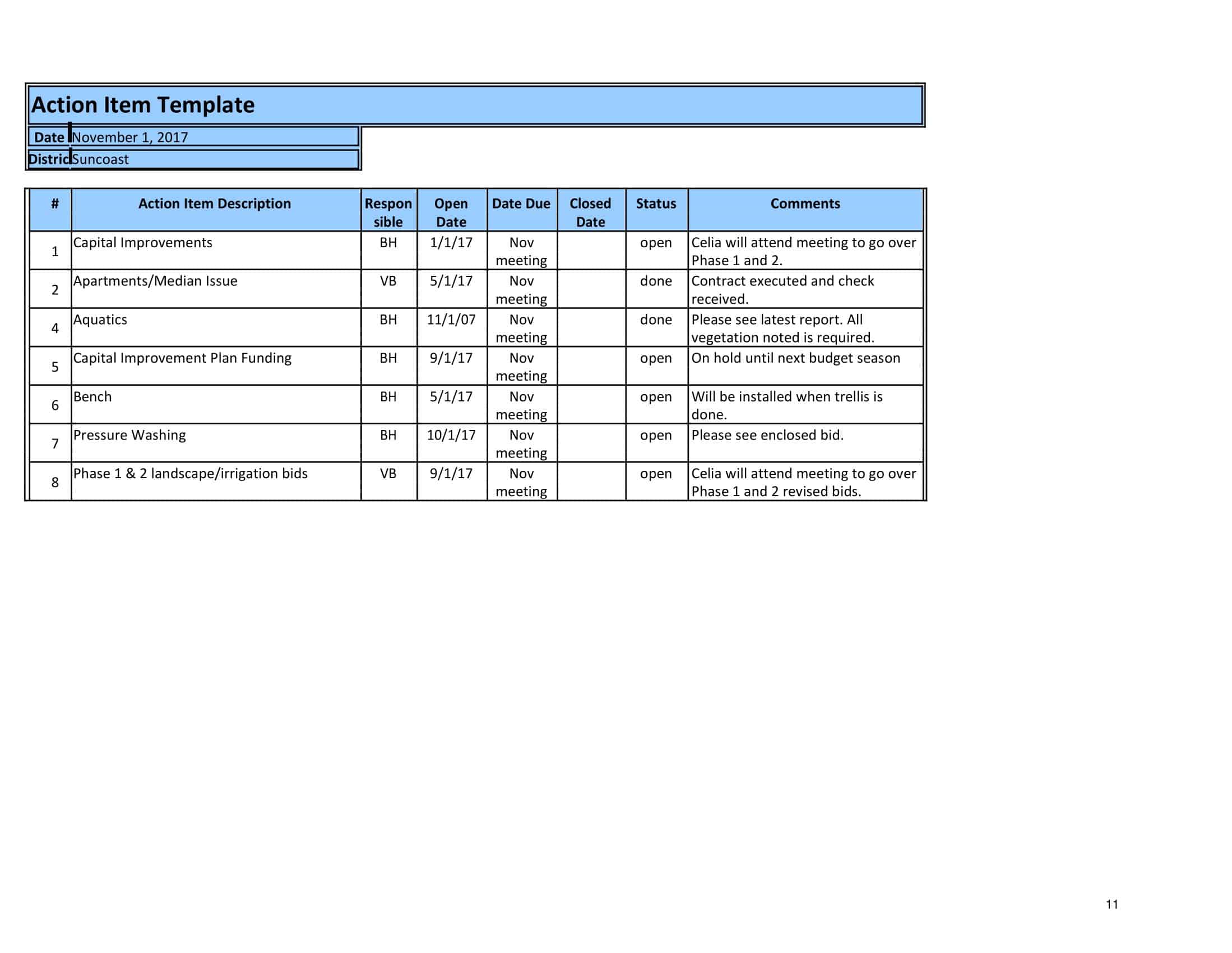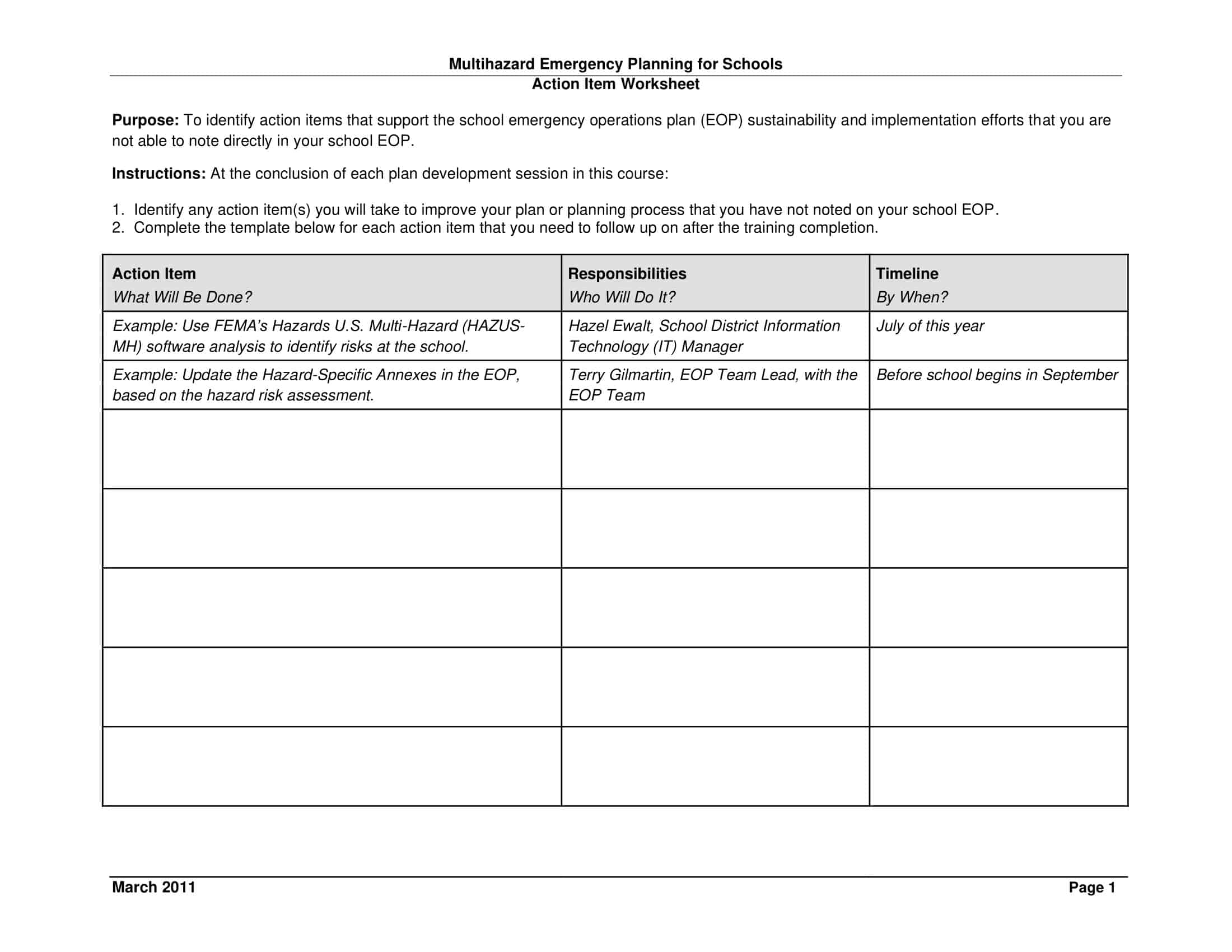To be effective in your businesses, you need to be able to prioritize different tasks that you need to take care of with action item lists. Action items lists will help you ensure that your actions are in place and that everything is being taken care of.
These lists will not just help you in getting organized, but they will also help you make the right decisions by giving you a clear picture of the situation at hand. There are many ways to come up with an action item list, all that matters is that it matches the needs of your business. The best way for you to come up with this list is by following an action item template, as this template helps guide you through the whole process.
Table of Contents
Action Item Templates
Action Item Templates are essential tools that help streamline and organize tasks and responsibilities within a team or organization. They provide a structured format for capturing, tracking, and monitoring action items, ensuring effective communication, accountability, and timely completion of tasks. These templates serve as a reference point for team members, enabling them to stay focused, prioritize their work, and collaborate efficiently.
Action Item Templates can be tailored to meet the specific needs and preferences of a team or organization. They can be created using various tools, such as spreadsheets, project management software, or collaborative platforms. The templates can be shared digitally, allowing team members to access and update them in real-time, promoting transparency and collaboration.
What is an action items list?

An action items list is a to-do list that you can use to track your progress on important tasks. It helps you stay focused by listing only the things you need to do.
An action items list can be used by anyone who needs to prioritize their work and then keep track of what they’ve completed. It’s especially useful for people who want to organize their tasks to see how much progress they’ve made on each project.
Types of action items templates
The following is a list of the most common types of action items templates:
Corrective Action
In corrective action templates, you list all of the issues that need to be fixed. You can create the template from scratch or download an action items list template and start using it. Either way, you should know the template you need for your project or company. Some of the most common types of action item lists include:
Corrective action is usually used to track problems that occur in a system or process. In this type of template, you list all the issues that need to be fixed and then follow up on each until they are resolved.
Decisive Action
In decisive action templates, you list all of the potential solutions to a problem. You can create your own decisive action template by identifying what needs to be done, who will do it, when it is done, and how much it’ll cost. Some other things worth noting about decisive action templates are that companies with multiple departments, like sales and marketing, often use them.
Project Management Action
If you are working on a project, you need to create an action list for it. A project management action item template will help you organize all the tasks that need to be done. The template can be simple or can have complex sections for different types of tasks. When creating a project management action item list, ensure you have all the relevant information before starting. For example, if your company is working on a new product launch, then include the date when it will happen and any other essential details in your action item list.
Priority Action
Sometimes, you need to know which task should be done first and which should be done later. In such cases, use priority action templates so that each task gets its own priority level. Also, assign a deadline for each task in order to ensure that everything gets done on time. You can use priority action templates if you want to keep track of deadlines while planning out your schedule of activities or work assignments.
Tips for writing better action items
Much like a good meeting, action items are all about getting things done. But there’s a difference between a meeting that gets things done and one that wastes everyone’s time.
Action items are the key to keeping meetings from wasting time. They’re also the key to ensuring people remember what they agreed to do. Here are some tips for writing better action items:
Write your action items for the reader.
When writing an action item, think about who will read it and how they’ll interact. If you send an email to a group of people, ensure everyone understands what they’re supposed to do next. If you’re creating a to-do list for yourself, make sure that it’s clear what each task entails and when it needs to be done by. In both cases, your goal is to get through the task and on to the next one as quickly as possible.
Use short sentences wherever possible.
If your action item is going into an email or document, keep each sentence short so that readers can quickly scan through them without getting bogged down by long sentences or paragraphs. You should break up large blocks of text into smaller chunks using bullet points or numbered lists so that readers can easily find specific information if needed.
Use bullets whenever possible.
Bullets are great for breaking up text because they help make your message easier on the eyes — plus, they help draw attention to key information within each section of an email or document.
Clarify relay items
If multiple people are working on the same task, ensure each individual has a clear idea of who is responsible for what. This will ensure communication between team members is communicated effectively, which can lead to delays in completing your project.
Provide context to the action items as notes or comments.
If you are working on a project with multiple components, each task must have its own place in this spreadsheet. If multiple people are involved in completing each task, provide their names and contact information in case the person assigned to the task cannot complete it.
Organize your spreadsheet by category or phase.
When outlining your plan for completion, consider which tasks need to be completed first and how long they will take so that others can be scheduled accordingly. This also helps prevent overlap between different phases of the same task — such as ordering supplies from an online vendor before designing something using those materials — which could lead to unnecessary delays in getting things done efficiently.
Final Thoughts
The action items template used for planning and tracking tasks will help you to keep the focus on your goals without getting sidetracked. By regularly reviewing the list, you’ll see how much progress you’ve made and maintain the motivation to complete active projects. It’s also a great way to improve leadership skills by teaching others to hold themselves accountable for their actions.
FAQs
What is an Action Item?
An Action Item is a discrete task or step that arises from a meeting, discussion, or project that requires follow-up or execution. It is typically assigned to an individual or team for completion by a specific deadline.
How is an Action Item different from a task?
While both refer to something that needs to be done, an Action Item typically arises as a result of a discussion or decision-making process and may not have been previously planned. A task, on the other hand, is often a pre-planned piece of work.
Who is responsible for tracking Action Items?
Usually, the meeting facilitator, project manager, or team leader is responsible for documenting and tracking Action Items. However, the assigned individual or team is responsible for completing the Action Item.
How should Action Items be documented?
Action Items should be clearly written with a defined outcome, assigned individual or team, and a set deadline. They can be captured in meeting minutes, task lists, project management tools, or action item trackers.
What makes an Action Item effective?
An effective Action Item is specific, actionable, and time-bound. It should be clear who is responsible for the item and what the expected outcome is by a specific date.
How can I prioritize Action Items?
Prioritization can be based on factors like urgency, importance, dependencies on other tasks, or available resources. Tools like the Eisenhower Matrix or MoSCoW method can help in prioritizing.
What should I do if I cannot complete an Action Item by the deadline?
If you anticipate a delay, communicate it to the relevant stakeholders or the person tracking the Action Items as soon as possible. Provide a reason for the delay and propose a new deadline.
How can I ensure Action Items are not forgotten?
Regular follow-ups, reminders, and status update meetings can help ensure that Action Items are on track. Using digital tools that offer notifications and reminders can also be beneficial.
Why are Action Items important in a meeting context?
Action Items provide clarity on the next steps and ensure that decisions made during a meeting lead to tangible outcomes. They promote accountability and forward momentum in projects or processes.
Can an Action Item be reassigned?
Yes, if the assigned individual or team cannot complete the Action Item, it can be reassigned with proper communication and agreement among stakeholders.


















































![Free Printable Credit Card Authorization Form Templates [PDF, Word, Excel] 1 Credit Card Authorization Form](https://www.typecalendar.com/wp-content/uploads/2023/06/Credit-Card-Authorization-Form-150x150.jpg)
![Free Printable Stock Ledger Templates [Excel,PDF, Word] 2 Stock Ledger](https://www.typecalendar.com/wp-content/uploads/2023/08/Stock-Ledger-150x150.jpg)
![Free Printable Financial Projections Templates [Excel, PDF] 3 Financial Projection](https://www.typecalendar.com/wp-content/uploads/2023/05/Financial-Projection-1-150x150.jpg)
